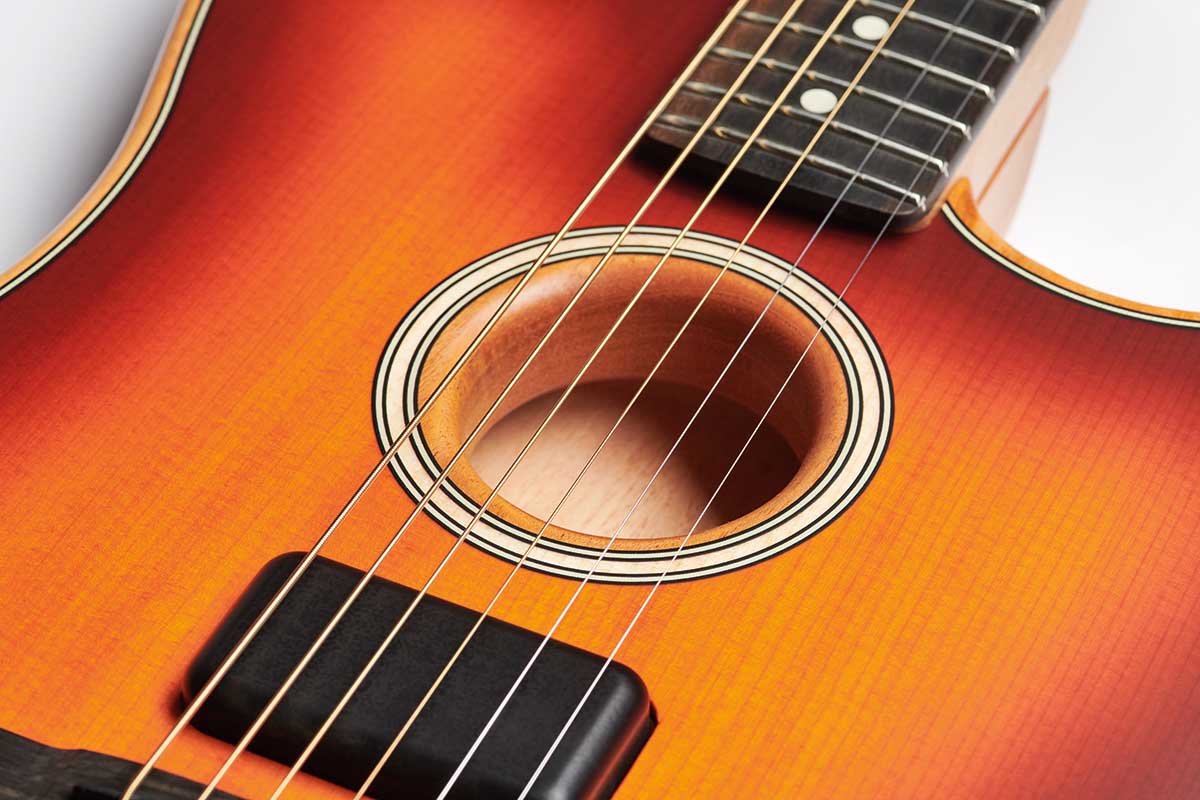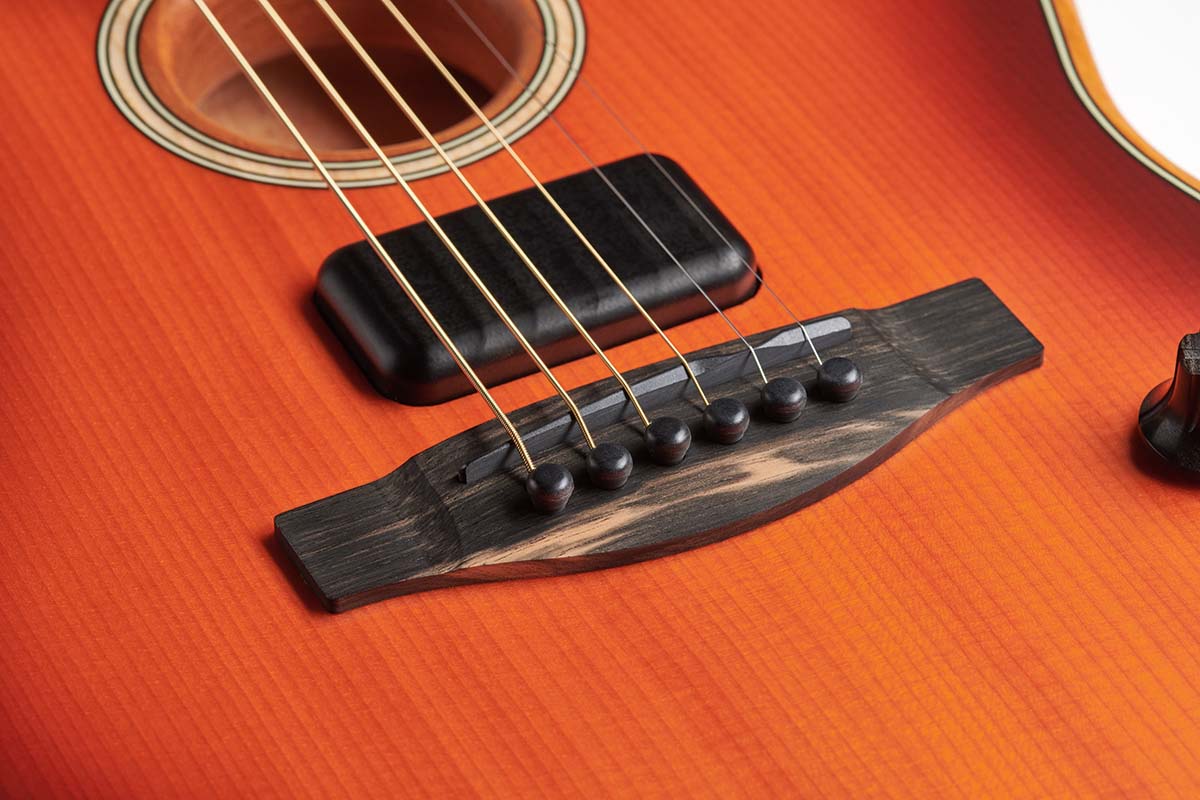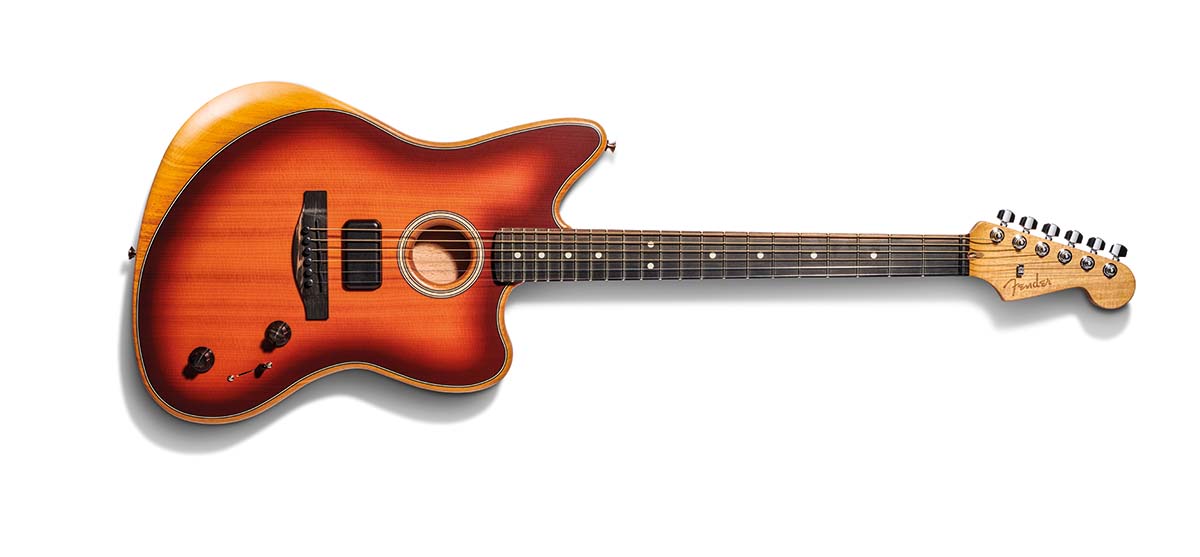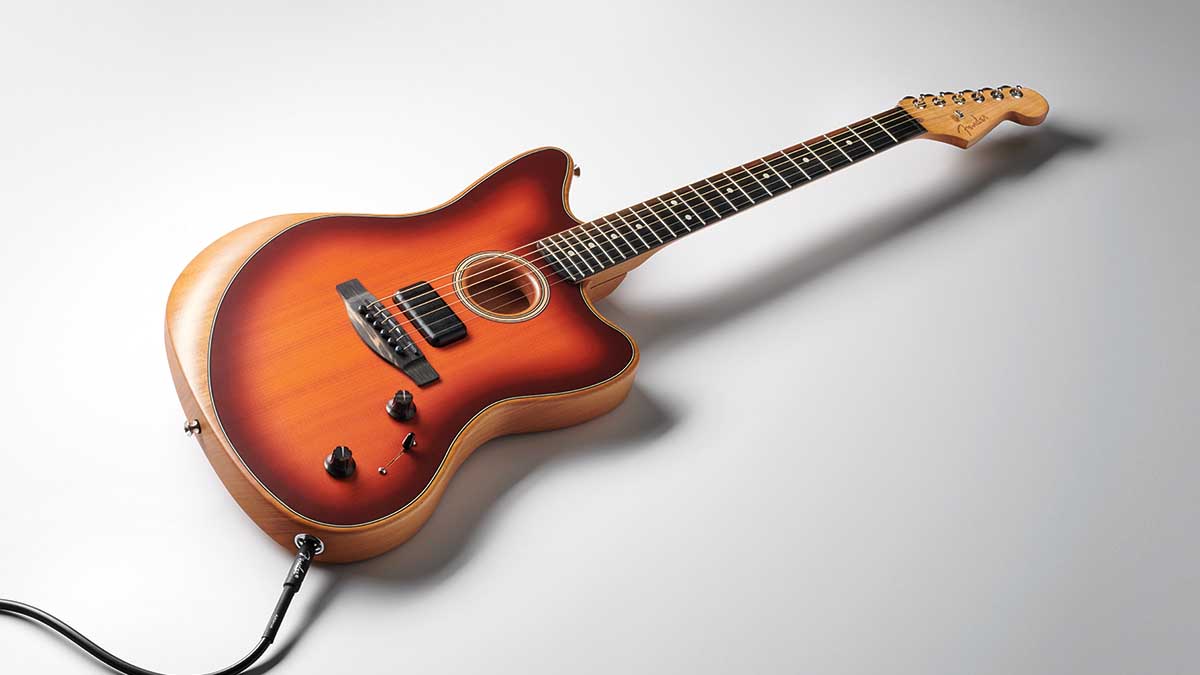GuitarPlayer Verdict
A bold, progressive design that goes deeper into the hybrid acoustic-electric concept, the American Acoustasonic Jazzmaster will reward the intrepid with a rich array of sounds from a user-friendly instrument.
Pros
- +
Infinitely versatile hybrid tonal spectrum.
- +
Easy playability and a straightforward interface.
Cons
- -
Humbucker is hot and sharp, with no tone control.
- -
Requires A/B box to split into dual amps.
You can trust Guitar Player.
Is it an acoustic guitar or an electric guitar? Neither? Both? How about all of the above! The third iteration of Fender’s Acoustasonic moves the series forward with fresh sounds, features, and colors on the Jazzmaster’s offset body shape while providing the hybrid platform and easy-playing electric neck profile of its predecessors, the Acoustasonic Telecaster and Stratocaster.
The Jazzmaster form wears the Acoustasonic aesthetic particularly well, but there’s more to this story than a beautiful new body. Each incarnation of the Acoustasonic offers opportunities to fuel the Fishman-designed Acoustic Engine, which digitally interacts with the body’s unique properties to create a novel tonal palette.
Being the largest Acoustasonic so far, the Jazzmaster naturally offers a bit more. For the uninitiated, each Acoustasonic model features three pickups – a piezo under saddle, an enhancing body sensor, and a model-specific magnetic in the bridge position – all on a bolt-on chambered body featuring an innovative ported chamber dubbed the Stringed Instrument Resonance System.
The articulate analog tone is like a cross between a resonator, a banjo, a flattop, and a naked electric guitar. A five-way voice selector and blend knob with A (counter-clockwise) and B sides offers 10 distinct voice pairs, plus myriad blending opportunities.

Fender Acoustic honcho Billy Martinez says, “We’ve always looked at the Acoustasonic as an acoustic first, with the electric element as icing on the cake. People naturally want to apply pigeonhole tonal comparisons to the electric counterparts and other Acoustasonics, but our goal for each iteration is to create a distinct instrument.
"The hybrid design includes such absolutely acoustic elements as phosphor-bronze strings feeding an ebony bridge, which makes deeper comparisons to an electric Jazzmaster with its unique tremolo bridge system and single-coil pickups rather irrelevant. The Acoustasonic Jazzmaster is an entirely different animal."
The guitar offers four completely new voices. Two of them, Mahogany Jumbo and All-Mahogany Small Body, reside in position 4.
The sounds seemed to match their designations and felt different as well. I could readily distinguish the lighter, more fundamental-forward mahogany voices from their woolier, more complex rosewood counterparts.
Two other brand-new voices, Lo-Fi Piezo and Lo-Fi Piezo Crunch, reside in position 2. The former sounds more like a typical acoustic-electric, while the latter sounds a bit gnarlier. Acoustic aficionados typically eschew such tones, but they certainly honor the Jazzmaster’s legendary punk spirit.

Martinez explains: “The larger Jazzmaster body is so resonant that for position 2A we treated it in the same vein as a traditional acoustic-electric, where the body does the work and the undersaddle piezo picks it up. Roll the blend knob toward side B, and the DSP adds a raw crunch via impulse-response interaction layered with digital electric guitar images.
“That’s the most mesmerizing sound. It’s not coming from the humbucker at all, even though it kind of sounds like it could be. This is actually the first Acoustasonic not to have a position that blends the magnetic pickup with the piezo. The whole premise of the Acoustasonic platform is innovation, and we wanted to set the Jazzmaster apart. We’re getting a lot of excitement from artists about the position-2 tones.”
As a percussive player, I gravitate toward the middle position because it’s the only one that incorporates the Fishman Enhancer body sensor with a turn toward side B, and, boy, does it offer all the pop any slapper/tapper could ever need!
I loved the detailed midrange of the Rosewood Auditorium voice on side A, and blending in a bit of that body builder goes a long way. I found myself falling back on the Rosewood Dreadnought voice in position 5A most often for a traditional tone.
Only position 1 features the humbucker, which was designed by Fender’s chief engineer and pickup guru Tim Shaw. The Shaw-bucker is downright rowdy. Fire it up and you’re instantly in lead mode, able to shred in the short rows more easily on the Jazzmaster because its carved neck heel provides easy access to the upper register.
Position 1A is Fat/Semi-Clean, and that little humbucker produces a hot, sharp sound. Backing off that attack is a bit of an issue because there is no tone control. I wound up employing a Fender Smolder Acoustic Distortion pedal for tone shaping and smoothing overdriven tones.
Like its Tele and Strat siblings, the Acoustasonic Jazzmaster takes on its alter ego when plugged into an electric amp. Now the Shaw-bucker knifes through a band mix like a machete through a jungle. Blend toward side B, where onboard overdrive processing resides, to enter feral “Rebel Rebel” territory. Having overdrive onboard is sure handy.

The acoustic settings take on different characters through a touch-sensitive tube amp such as the 1983 Fender Super Champ I used for testing.
The Acoustasonic Jazzmaster is outrageously responsive, and I was able to go from hushed articulate tones to blazing sounds à la Neil Young and Crazy Horse simply by strengthening the attack, or blending toward side B in positions 2 and 3. Be careful bringing in the body enhancer as it acts kind of like a mic and is quite powerful.
It will push the tubes and is liable to produce feedback or potentially overwhelm a low-power amp, as it did my Champ when I got carried away. I appreciated the hybrid Jazzmaster sounds on their own merits, and had a blast creating all sorts of interesting tonal blends. My favorite position for the blend knob was usually somewhere in the mysterious middle.
There is a bit of dilemma for die-hard dualers such as myself that want it both ways. You can’t split the piezo and magnetic signals, even with a stereo cable, but you can use an A/B splitter box to get the full benefit of the summed acoustic-electric signal. Most players probably won’t fuss with that, but the dual-amp tone is a hybrid dream.

Performers need to choose whether this ultra-versatile axe is primarily an acoustic or electric vehicle on any given occasion and feed the signal into the appropriate amp.
Your playing will wind up leaning that direction as well. The good news is that you can’t lose either way. The Acoustasonic Jazzmaster sounds great direct into a P.A. or recording interface. Plug-and-play studio applications alone could keep a player busy for the rest of the pandemic.
Celebrating its 75th anniversary this year, Fender claims that the American Acoustasonic Jazzmaster is the iconic brand’s most sonically diverse guitar to date. It’s hard not to agree.
In the March issue’s Frets feature, Jimmy Buffett mentioned that if he were starting out right now, he’d go with an Acoustasonic because it delivers the most bang for the buck on the modern market. That’s hard to argue with as well.
Stratocaster cats and Telecaster troubadours should by all means audition one of those Acoustasonics. Fans of a bigger acoustic sound, jacks-of-all trades, and players looking for a dazzlingly distinctive acoustic-electric will likely dig this Jazzmaster.
It’s a bold-sounding, shape-shifting guitar Swiss Army Knife. And are there perhaps more Acoustasonics in Fender’s future? Martinez says, “We haven’t even scratched the surface.”
Specifications
- PRICE: $1,999 street, deluxe gig bag included
- NUT WIDTH: 1.69”, Tusq
- NECK: Mahogany, modern “Deep C” profile
- FRETBOARD: Ebony, 25.5” scale, 12” radius
- FRETS: 22, narrow tall
- TUNERS: Fender standard cast; sealed, staggered with chrome finish
- BODY: Mahogany body with solid Sitka spruce top
- BRIDGE: Ebony modern asymmetrical with GraphTech Tusq saddle
- PICKUPS: Fishman Matrix undersaddle piezo, Fishman Enhancer internal body sensor, Acoustasonic Shawbucker (bridge)
- CONTROLS: Volume, blend knob, 5-way blade switch (for selecting voice pairs)
- POWER: Rechargeable lithium-ion battery. Metal output jack plate houses mini-USB charger slot and battery status indicator
- FACTORY STRINGS: Fender Dura-Tone 860CL coated phosphor bronze .011–.052
- WEIGHT: 5.5 lbs
- BUILT: USA
- CONTACT: Fender
Jimmy Leslie has been Frets editor since 2016. See many Guitar Player- and Frets-related videos on his YouTube channel, and learn about his acoustic/electric rock group at spirithustler.com.
Guitar Center's Guitar-A-Thon is back, and it includes a colossal $600 off a Gibson Les Paul, $180 off a Fender Strat, and a slew of new exclusive models
"We tried every guitar for weeks, and nothing would fit. And then, one day, we pulled this out." Mike Campbell on his "Red Dog" Telecaster, the guitar behind Tom Petty & the Heartbreakers' "Refugee" and the focus of two new Fender tribute models











